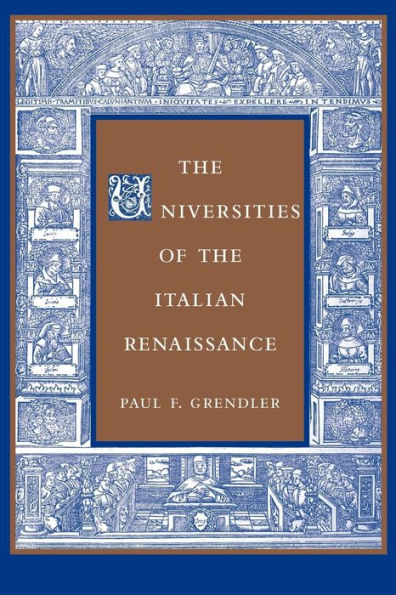

Paperback
-
PICK UP IN STORECheck Availability at Nearby Stores
Available within 2 business hours
Related collections and offers
Overview
Italian Renaissance universities were Europe's intellectual leaders in humanistic studies, law, medicine, philosophy, and science. Employing some of the foremost scholars of the time—including Pietro Pomponazzi, Andreas Vesalius, and Galileo Galilei—the Italian Renaissance university was the prototype of today's research university. This is the first book in any language to offer a comprehensive study of this most influential institution.
In this magisterial study, noted scholar Paul F. Grendler offers a detailed and authoritative account of the universities of Renaissance Italy. Beginning with brief narratives of the origins and development of each university, Grendler explores such topics as the number of professors and their distribution by discipline, student enrollment (some estimates are the first attempted), famous faculty members, budget and salaries, and relations with civil authority. He discusses the timetable of lectures, student living, foreign students, the road to the doctorate, and the impact of the Counter Reformation. He shows in detail how humanism changed research and teaching, producing the medical Renaissance of anatomy and medical botany, new approaches to Aristotle, and mathematical innovation. Universities responded by creating new professorships and suppressing older ones. The book concludes with the decline of Italian universities, as internal abuses and external threats—including increased student violence and competition from religious schools—ended Italy's educational leadership in the seventeenth century.

Product Details
| ISBN-13: | 9780801880551 |
|---|---|
| Publisher: | Johns Hopkins University Press |
| Publication date: | 11/03/2004 |
| Series: | Johns Hopkins Paperback |
| Pages: | 616 |
| Product dimensions: | 6.12(w) x 9.25(h) x 1.26(d) |
| Age Range: | 18 Years |
About the Author
Table of Contents
List of IllustrationsList of TablesPrefaceAbbreviationsPart I: The Universities of Italy1. Bologna and PaduaThe Italian UniversityBologna: Second Hald of the Twelfth CenturyBologna in the Sixteenth CenturyPadua, 1222Padua after 15092. Naples, Siena, Rome, and PerugiaNaples, 1224Diena, 1246Rome, 1240sPerugia, 13083. The Second Wave: Pisa, Florence, Pavia, Turin, Ferrara, and CataniaPisa, 1343Florence, 1348Pavia, 1361Turin, 1411–1413Ferrara, 1442Catania, 14454. The Third Wave: Macerata, Salerno, Messina, and ParmaMacerata, 1540–1541Salerno, c. 1592Messina, 1596Parma, 1601Incomplete UniversitiesPaper UniversitiesConclusion5. The University in ActionThe Organization of InstructionLatinDisputationsCivil Authority and Student PowerProfessorsStudent LivingResidence CollegesThe DoctorateThe Cost of DegreesAlternate Paths to the DoctorateDoctorates from Counts PalatineThe Counter ReformationPart II: Teaching and Research6. The Studia HumanitatisGrammar and Rhetoric in the Fourteenth-Century UniversityHumanists Avoid the University, 1370–1425Humanists Join the University, 1425–1450Humanistic Studies Flourish, 1450–1520Court and Classroom: Changing Employment for HumanistsHumanistic Studies at Other UniversitiesThe Sixteenth CenturyCurricular TextsTeaching and ResearchHumanists in the University: A Summation7. LogicLogic at PaduaLogic at Other UniversitiesTeaching and ResearchDemonstrative RegressConclusion8. Natural PhilosophyAristotelian Curricular TextsGreek Texts and CommentariesInanimate World, Scientific Method, and the SoulThe Debate on the Immortality of the Intellective SoulThe Immortality of the Soul after PomponazziPlatonic Philosophy in the UniversitiesContinuity and Decline of Aristotelian Natural Philosophy9. The Medical CurriculumMedieval Medical KnowledgeThe Medical Curriculum in 1400Medical HumanismThe Anatomical RenaissanceBodies for DissectionUniversity Anatomy after VesaliusClinical MedicineMedical BotanyConclusion10. Theology, Metaphysics, and Sacred ScriptureFrom Mendicant Order Studia to Faculties of TheologyFaculties of TheologyDoctorates of TheologyTheology, Metaphysics, and Sacred Scripture at the University of PaduaUniversities Teaching Theology ContinuouslyUniversities Reluctant to Teach TheologyErasmus's Doctorate of TheologyTeaching TextsThe Reputation of TheologyItalian Convent and University Theology, 1400–160011. Moral PhilosophyMoral Philosophy in the Late Middle AgesHumanistic Moral Philosophy at the University of FlorenceMoral Philosophy in Other UniversitiesTeaching Moral Philosophy12. MathematicsStatutory TextsThe Renaissance of MathematicsProfessors of Astrology, Astronomy, and MathematicsLuca PacioliThe Progress of Mathematics13. LawMos ItalicusTeaching TextsHumanistic JurisprudenceThe Decline of Canon LawPadua and BolognaPavia and RomeSiena and the SozziniFlorence and PisaThe Other UniversitiesConclusionPart III: Recessional14. The Decline of Italian UniversitiesConcern for the UniversitiesCompetition from Religious Order Schools: The Jesuit School at PaduaCompetition from Religious Order Schools: Schools for NoblesDegrees from Local Colleges of Law and MedicinePrivate Teaching and Other Pedagogical AbusesPrivate Anatomy Teaching at PaduaThe Shrinking Academic CalendarFinancial ProblemsFaculty ProvincialismStudent ViolencePositive DevelopmentsA Weakened InstitutionConclusionAppendix: Faculty Size and Student EnrollmentsBibliographyIndexWhat People are Saying About This
A magnificent achievement. Paul Grendler has written a stunningly comprehensive, detailed, and insightful history of the Italian universities from their origins to the eighteenth century. It will unquestionably become the standard work on the subject and remain so for a very long time. More than an institutional history, it is also a history of Italian culture over a span of five hundred years. Law, medicine, humanism, mathematics, philosophy, theology, and science all receive lucid and informative treatment.—John Monfasani, State University of New York at Albany
A magnificent achievement. Paul Grendler has written a stunningly comprehensive, detailed, and insightful history of the Italian universities from their origins to the eighteenth century. It will unquestionably become the standard work on the subject and remain so for a very long time. More than an institutional history, it is also a history of Italian culture over a span of five hundred years. Law, medicine, humanism, mathematics, philosophy, theology, and science all receive lucid and informative treatment.
— John Monfasani, State University of New York at Albany
